0 引言
1 地质背景
2 岩相类型划分
2.1 岩相划分依据
表1 贵州下寒武统黑色页岩平均矿物组成统计Table 1 Statistics of average mineral composition of Lower Cambrian black shale in Guizhou |
| 地点 | 矿物组成/% | |||||
|---|---|---|---|---|---|---|
| 石英 | 长石 | 方解石 | 白云石 | 黄铁矿 | 黏土矿物 | |
| 金页1井 | 35.3 | 5.5 | 6.6 | 0.0 | 3.6 | 48.7 |
| 岩孔箐口 | 14.0 | 18.0 | 0.0 | 0.0 | 0.0 | 68.0 |
| 织金桂果 | 51.0 | 1.0 | 7.0 | 2.0 | 1.0 | 38.0 |
| 观山湖区百花湖 | 42.0 | 22.0 | 0.0 | 5.0 | 6.0 | 25.0 |
| 贵阳龙水 | 66.0 | 1.0 | 0.0 | 0.0 | 0.0 | 30.0 |
| 开阳芭蕉寨 | 60.0 | 2.0 | 1.0 | 0.0 | 0.0 | 37.0 |
| 开阳磷矿 | 54.0 | 1.0 | 0.0 | 0.0 | 0.0 | 45.0 |
| 开阳双流 | 57.0 | 5.0 | 0.0 | 0.0 | 0.0 | 38.0 |
| 清镇温水村 | 42.0 | 22.0 | 0.0 | 5.0 | 6.0 | 25.0 |
| 翁昭中院 | 51.0 | 1.0 | 0.0 | 5.0 | 4.0 | 39.0 |
| 天星1井 | 54.4 | 8.9 | 2.2 | 7.9 | 8.7 | 17.8 |
| 丹寨翻仰 | 54.0 | 9.0 | 0.0 | 1.0 | 0.0 | 36.0 |
| 丹寨南皋 | 57.5 | 5.8 | 1.7 | 0.0 | 1.2 | 31.6 |
| 黄页1井 | 52.2 | 17.8 | 6.3 | 5.6 | 0.3 | 17.9 |
| 凯里 | 54.0 | 0.0 | 0.0 | 0.0 | 0.0 | 41.0 |
| 凯里下司 | 59.0 | 4.0 | 0.0 | 0.0 | 0.0 | 32.0 |
| 麻江 | 62.0 | 4.0 | 2.0 | 3.0 | 0.0 | 25.0 |
| 台江九龙山 | 47.0 | 12.5 | 0.0 | 0.0 | 1.5 | 39.0 |
| 镇远 | 44.0 | 0.0 | 2.0 | 13.0 | 5.0 | 33.0 |
| 镇远都坪 | 52.0 | 8.0 | 4.0 | 4.5 | 3.5 | 27.0 |
| 镇远火车站 | 58.0 | 15.0 | 0.0 | 11.0 | 5.0 | 11.0 |
| 镇远江古 | 71.0 | 14.0 | 0.0 | 5.0 | 0.0 | 10.0 |
| 镇远清溪 | 57.0 | 13.0 | 0.0 | 0.0 | 9.0 | 21.0 |
| 镇远五里坡 | 46.0 | 8.0 | 16.0 | 0.0 | 3.0 | 27.0 |
| 惠水孟寨 | 48.0 | 15.0 | 0.0 | 0.0 | 0.0 | 37.0 |
| 荔波洞独 | 63.0 | 3.0 | 0.0 | 0.0 | 0.0 | 34.0 |
| 三都 | 55.0 | 0.0 | 4.0 | 0.0 | 0.0 | 36.0 |
| 三都水碾 | 65.0 | 3.5 | 0.0 | 0.5 | 0.0 | 31.0 |
| 瓮安 | 62.0 | 0.0 | 1.5 | 0.0 | 0.5 | 36.0 |
| 瓮安庙湾 | 45.0 | 7.0 | 0.0 | 0.0 | 0.0 | 48.0 |
| 瓮安小河山 | 53.0 | 14.0 | 0.0 | 0.0 | 0.0 | 33.0 |
| 瓮安永和 | 63.0 | 2.0 | 0.0 | 2.0 | 0.0 | 33.0 |
| 江口桃映 | 58.0 | 10.0 | 0.0 | 0.0 | 10.0 | 22.0 |
| 石阡中坝 | 49.0 | 5.0 | 11.0 | 0.0 | 0.0 | 35.0 |
| 松桃 | 60.0 | 1.0 | 5.0 | 0.0 | 3.0 | 30.0 |
| 松桃林朝沟 | 60.0 | 6.0 | 0.0 | 0.0 | 0.0 | 34.0 |
| 松桃牛郎 | 49.0 | 16.0 | 0.0 | 0.0 | 0.0 | 35.0 |
| 松桃世昌 | 34.0 | 0.0 | 5.0 | 48.0 | 5.0 | 8.0 |
| 沿河夹石 | 43.0 | 5.0 | 0.0 | 0.0 | 0.0 | 52.0 |
| 印江石梁 | 52.0 | 12.0 | 0.0 | 0.0 | 0.0 | 36.0 |
| 铜仁市区附近 | 66.1 | 6.0 | 0.6 | 9.0 | 1.2 | 17.1 |
| 湄潭 | 50.0 | 0.0 | 5.0 | 6.0 | 0.0 | 32.0 |
| 仁页1井 | 54.8 | 6.0 | 3.5 | 1.8 | 3.3 | 30.6 |
| 松林大巴 | 42.0 | 4.0 | 0.0 | 22.0 | 6.0 | 26.0 |
| 余庆小腮 | 71.0 | 6.0 | 0.0 | 0.0 | 0.0 | 23.0 |
| 遵义 | 44.0 | 0.0 | 6.0 | 1.0 | 0.0 | 49.0 |
| 遵义金顶山 | 56.0 | 6.0 | 0.0 | 6.0 | 0.0 | 32.0 |
| 遵义毛石 | 56.0 | 2.0 | 0.0 | 0.0 | 0.0 | 42.0 |
| 遵义松林 | 46.0 | 6.0 | 0.0 | 0.0 | 0.0 | 48.0 |
| 凤参1井 | 40.5 | 23.6 | 6.9 | 4.0 | 19.6 | |
| 正页1井 | 42.5 | 29.6 | 4.2 | 4.0 | 5.1 | 13.3 |
表2 海相页岩岩相类型划分方案Table 2 Lithofacies classification scheme of marine shale |
| 岩相组 | 岩相 | 矿物组成/% | ||
|---|---|---|---|---|
| 石英+长石 | 方解石+白云石 | 黏土矿物 | ||
| 硅质页岩(I) | 硅质页岩(I1) | >50 | <25 | <25 |
| 富黏土硅质页岩(I2) | >50 | <25 | 25~50 | |
| 富钙硅质页岩(I3) | >50 | 25~50 | <25 | |
| 钙质页岩(II) | 钙质页岩(II1) | <25 | >50 | <25 |
| 富硅钙质页岩(II2) | 25~50 | >50 | <25 | |
| 富黏土钙质页岩(II3) | <25 | >50 | 25~50 | |
| 黏土质页岩(III) | 黏土质页岩(III1) | <25 | >50 | <25 |
| 富硅黏土质页岩(III2) | <25 | >50 | 25~50 | |
| 富钙黏土质页岩(III3) | 25~50 | >50 | <25 | |
| 混合页岩(IV) | 黏土/硅混合页岩(IV1) | 25~50 | <30 | 25~50 |
| 硅/钙混合页岩(IV2) | 25~50 | 25~50 | <30 | |
| 钙/黏土混合页岩(IV3) | <30 | 25~50 | 25~50 | |



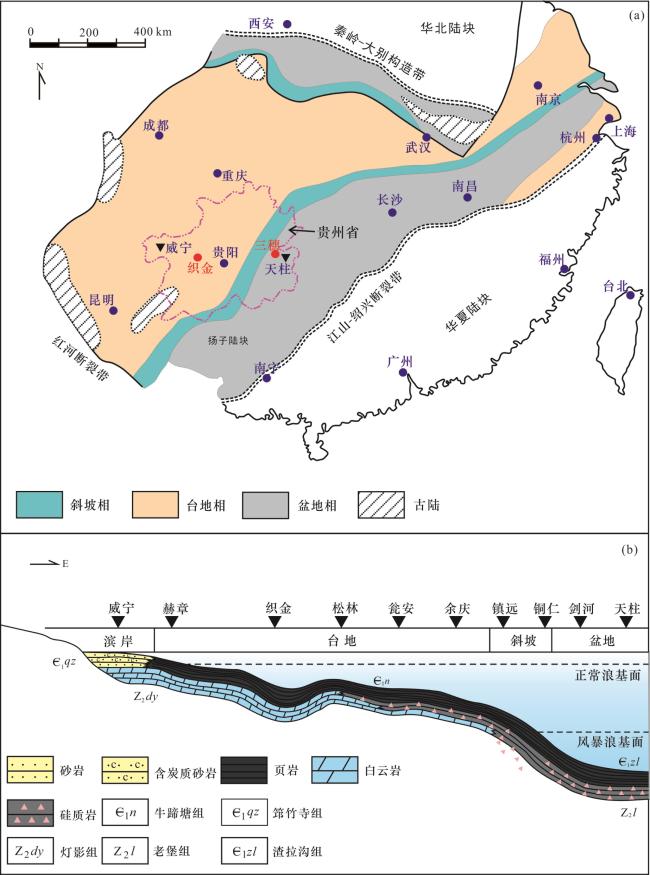
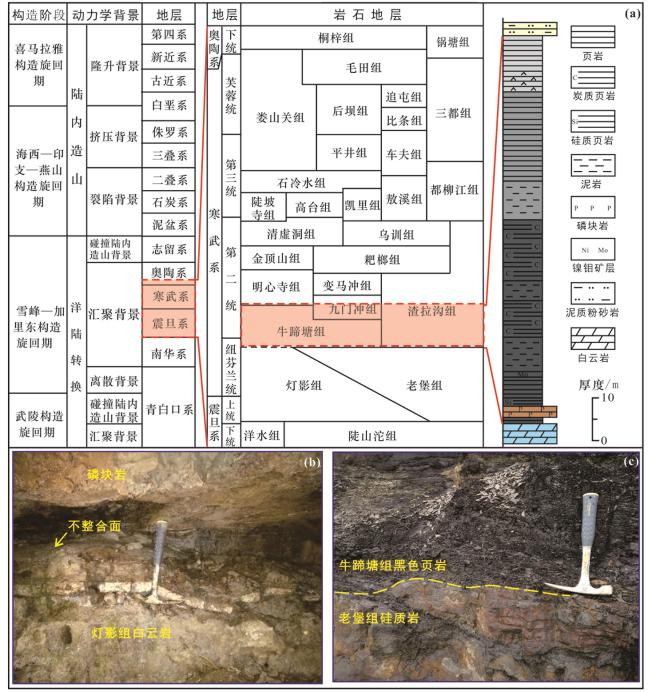
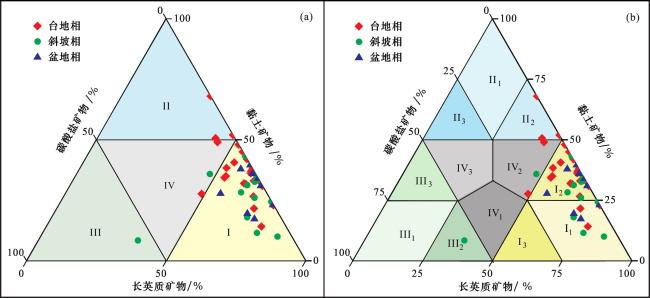
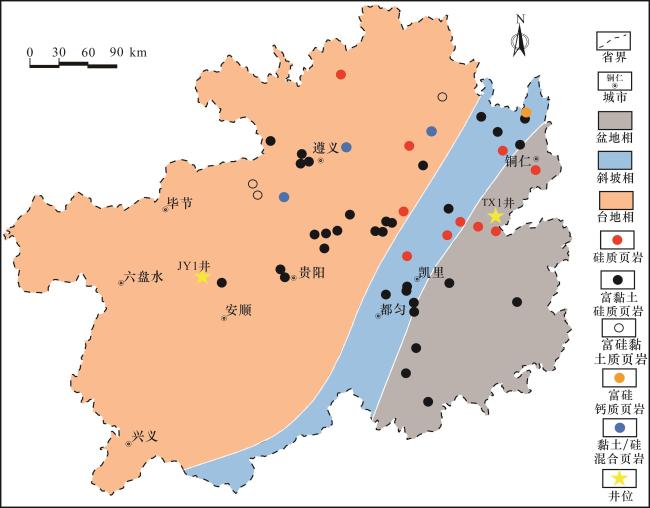


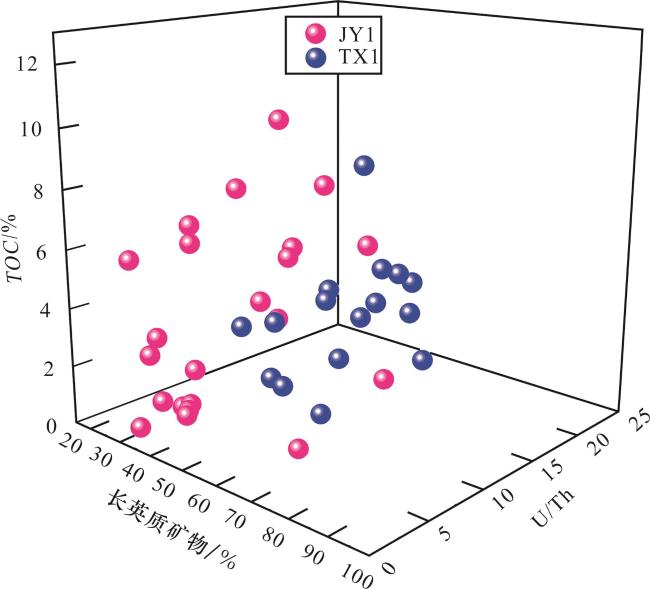
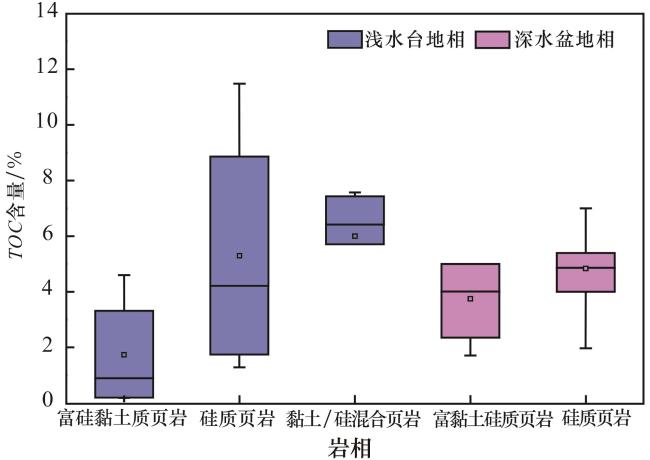
 甘公网安备 62010202000678号
甘公网安备 62010202000678号